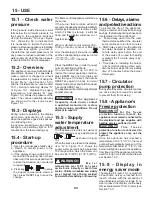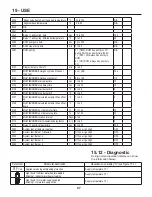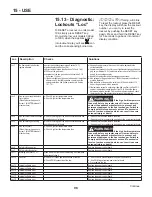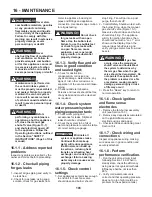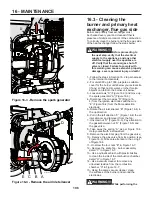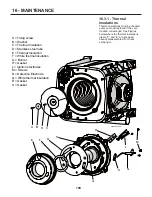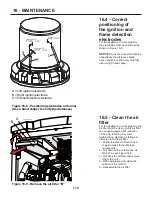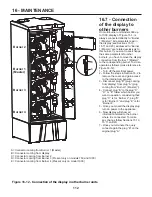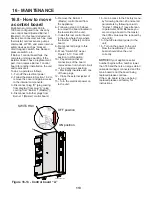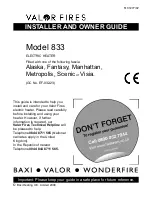
104
16.1.9 - Flame inspection
1.- Inspect flame through sigh glass;
2.- If the flame is unsatisfactory at
either high fire or low fire, clean the
burner following Section 16.3.
16.1.10 - Check flame
signal
1.- Start unit and perform the
procedure of Section 14.8 to check
the flame signal;
2.- At high fire and low fire the flame
signal (parameter 1008) should be
within values given in Section 17,
header “ionisation current”. A lower
flame signal may indicate a fouled
or damaged flame sense electrode.
If cleaning the flame sense
electrode does not improve, ground
wiring is in good condition, and
ground continuity is satisfactory,
replace the flame sense electrode.
16.1.11 - Check relief
valve
Inspect the relief valve and lift the
lever to verify flow. Before operating
any relief valve, ensure that it is piped
with its discharge in a safe area to
avoid severe scald potential. Read
Section 7.5 before proceeding further.
Relief valve should be re-inspected
at least once every three years, by
a licensed plumbing contractor or
authorized inspection agency, to
ensure that the product has not been
affected by corrosive water conditions
and to ensure that the valve and
discharge line have not been altered
or tampered with illegally.
Certain naturally occurring conditions
may corrode the valve or its
components over time, rendering the
valve inoperative. Such conditions are
not detectable unless the valve and its
components are physically removed
and inspected. This inspection must
only be conducted by a plumbing
contractor or authorized inspection
agency – not by the user.
WARNING!!!
Failure to
re-inspect the relief valve as
directed could result in unsafe
pressure buildup, which can
result in severe personal injury,
death, or substantial property
damage.
16.1.12 - Check appliance
area
WARNING!!!
To prevent
potential of severe personal
injury, death, or substantial
property damage, eliminate
all materials discussed below
from the appliance vicinity and
the vicinity of the appliance
combustion air inlet.
If contaminants are found:
Remove products immediately
from the area. If they have
been there for an extended
period, call a qualified service
technician to inspect the
appliance for possible damage
from acid corrosion.
If products cannot be removed,
immediately call a qualified
service technician to re-pipe
vent and air piping and locate
vent termination/air intake
away from contaminated areas.
1.- Combustible/flammable materials --
Do not store combustible materials,
gasoline or any other flammable
vapors or liquids near the appliance.
Remove immediately if found;
2.- Air contaminants -- Products
containing chlorine or fluorine,
if allowed to contaminate the
appliance intake air, will cause
acidic condensate in the appliance.
This will cause significant damage
to the appliance if allowed to
continue. Read the list of potential
materials listed in Section 5.1.1.
If any of these products are in the
room from which the appliance
takes its combustion air, they must
be removed immediately or the
appliance combustion air (and vent
termination) must be relocated to
another area.
16.1.13 - Check pressure
gauge
1.- Make sure the pressure reading on
the appliance pressure gauge (item
“M” of Figure 15-1) does not exceed
the maximum working pressure.
Higher pressure may indicate a
problem with the expansion tank;
2.- Contact a qualified service
technician if problem persists.
16.1.14 - Check vent piping
1.- Visually inspect the vent outlet
termination to be sure it is
unobstructed. Visually inspect the
entire length of the flue gas vent
piping for any signs of blockage,
leakage, or deterioration of the
piping. Notify your qualified service
technician at once if you find any
problems.
WARNING!!!
Failure to
inspect the vent system as
noted above and have it repaired
by a qualified service technician
can result in vent system failure,
causing severe personal injury
or death.
16.1.15 - Check air piping
1.- Visually inspect the air inlet
termination to be sure it is
unobstructed. Inspect the entire
length of air piping to ensure piping
is intact and all joints are properly
sealed;
2.- Call your qualified service technician
if you notice any problems.
16.1.16 - Check
condensate drain system
1.- Inspect the condensate drain line,
condensate fittings and condensate
trap for signs of weeping or leakage;
2.- If you detect signs of leakage,
immediately contact your qualified
service technician to inspect the
appliance and system.
16.1.17 - Check appliance
piping (gas and water)
1.- If gas odor or leak is detected,
immediately shut down the appliance
following the procedures on page 3.
Call a qualified service technician;
2.- Visually inspect for leaks around
water piping. Also inspect the
circulators, relief valve, and fittings.
Immediately call a qualified service
technician to repair any leaks.
WARNING!!!
Have leaks
fixed at once by a qualified
service technician. Failure to
comply could result in severe
personal injury, death, or
substantial property damage.
16 - MAINTENANCE
Summary of Contents for Infinite Energy2 IW1000
Page 3: ...3 SAFETY INSTRUCTIONS...
Page 5: ...5 SAFETY INSTRUCTIONS...
Page 122: ...122 16 MAINTENANCE...
Page 126: ...126 18 SPARE PARTS Spare parts...
Page 154: ...154 21 SEQUENCE OF OPERATION...





